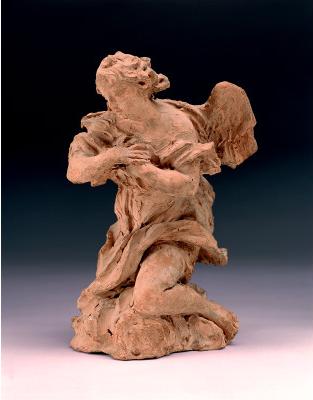| Workshop of Gian Lorenzo Bernini
Italian, 1598-1680
KNEELING ANGEL
SN 5445, Terra cotta sculpture in the round, c. 1626
From "The Pages".
ARTIST:
Bernini is to Baroque sculpture what Rubens is to Baroque painting. He dominated Roman art
for 50 years. Favored by a series of Popes, Bernini directed work at St Peter’s, in
Rome, starting when he was 26. (The most famous Baroque monument in the world is the
arcade of St Peter’s.) He was also active in Paris.
At 28 he received the commission for two life-sized marble angels to adorn the high altar
of San Agostino’s in Rome. Research has shown that this bozzetto, or model, may have
been designed by Berrnini for guidance in carving those commissioned figures. |
|
 |
SUBJECT:
The composition is open, dynamic, & dramatic. The wings symbolize divine mission
– here is a messenger from God. (Compare to Da Carton’s angelic messenger in
Hagar and Ishmael.) There are deep cuts in the skirt and under the arms, causing the
shadows which add texture and emphasize the spiraling line.
Like Rubens, Bernini employed many assistants for his grand projects. The actual execution
of this “sketch” (& of the full-scale marble sculpture eventually made for
the church) was given by Bernini to one of his best assistants, Giuliano Finelli, who was
an important sculptor in his own right.
TECHNICAL COMMENT:
Clay is particularly suited to the making of models, as it is malleable – the artist
can think, change, & create as he works. The presence of minerals in clay determines
its color when baked, and the most usual color is reddish: terra cotta. Once baked, the
piece can be enameled and fired. This piece is unfinished, and still bears finger prints
on its back.
As with many such sculptures (and paintings intended as altar pieces), positioning of the
finished work was an important part of its conception. This angel was meant to be viewed
from below. To receive the full impact, to feel the flutter of draperies and the intense
devotion shown on the angel’s face, kneel down and look up at it!
This work was studied at the Harvard University Art Museum and returned to us late in
1999. There, at the Strauss Center for Conservation, it was cleaned, received a test
sampling of the clay, and was given an overall X-radiograph. According to Antony Sigel,
Associate Conservator there, “The torso….appears to have been modeled from a
slender mass of clay with a vertical grain, to which more clay was added to build out the
form.” He adds, “This construction is not inconsistent with that employed in
creating some of the Fogg Museum’s Bernini bozzetti.”
Museum Label:
Kneeling Angel
c. 1626
Artist: Giuliano Finelli (execution)
Italian, 1601 or 1602-1653, active in Rome and Naples
Artist: Gian Lorenzo Bernini (design)
Italian, 1598-1680, active in Rome and Paris
Terracotta, 6 1/2 x 10 1/2 x 6 1/2 in. (16.5 x 26.7 x 16.5 cm)
This small terracotta angel is a bozzetto, or study, for a large-scale marble sculpture
that was designed for the high altar of the church of Sant'Agostino in Rome. The agitated
drapery and sense of movement are typical of Bernini's works. His sweeping, dramatic style
epitomized the High Baroque, and he was responsible for some of the most important
sculptures and monuments of 17th-century Rome. Like his northern contemporary Peter Paul
Rubens, Bernini required a large studio to handle his copious commissions. Though designed
by Bernini, this piece was likely executed by one of his assistants, possibly Giuliano
Finelli.
Museum purchase, 1960, SN5445
ringlingdocents.org
|